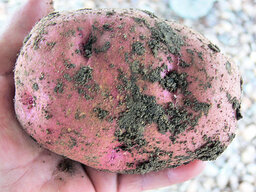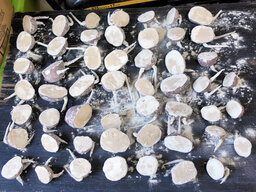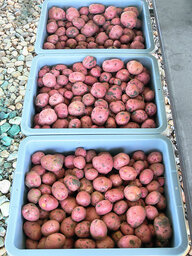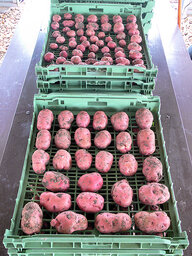Potatoes are one of America’s most popular vegetables... the average American eats about 125 pounds of potatoes & potato products each year.
The edible part of the plant is an underground stem called a tuber (no, it is not a root). Potatoes are an inexpensive source of carbohydrates & when prepared properly, provide good amounts of vitamins & minerals.
They are a cool season crop & thus are best grown in early spring & late fall when the days are warm & the nights are cool. Bear in mind that the tops of the plant cannot withstand frost so planting times are critical.
Varieties
The most common types of potatoes are red or white/yellow. Most red varieties store longer than do white varieties... on the other hand, most white varieties have better cooking qualities than red varieties.
Many gardeners plant some of each in the spring. The whites are used first & the reds stored for later use. Here in south central Texas, several varieties grow well:
Site selection
For best production, potatoes need full sun. They do best in a loose, well drained, slightly acid soil. Poorly drained soils often cause poor stands & low yields. Heavy soils can cause the tubers to be small & rough.
Soil preparation
Before tilling, remove the rocks, trash & any large sticks from the soil. Till the soil 8 to 12 inches deep & form your rows so that they are about 10" high & allow about 36" inches between the rows. The row height is vital for good drainage.
Because potatoes need adequate fertilizer early in the season, apply most of the fertilizer prior to planting. Use 1 lb of a complete fertilizer (10-20-10) for each 10 feet of row 1 inch below the seed piece. Do not allow the fertilizer to touch the seed piece.
Seed preparation
Unlike most other vegetables, potatoes are not grown from seed. Instead, pieces from the potato itself start new plants. Buy good seed potatoes that are free of disease & chemicals. Do not buy potatoes from a grocery store for planting. The seed potato contains buds or 'eyes' that sprout & grow into plants. The seed piece provides food for the plant until it develops a root system. If the seed is too small, it will produce a weak plant. One pound of seed potatoes will normally yield 9 to 10 seed pieces.
For a spring crop, cut large seed potatoes into pieces weighing about the size of a medium egg. Each seed piece must have at least one good eye. Cut the seeds 3 to 5 days before planting and coat them in powered sulphur to help prevent rotting (some folks use wood ash). put the cut seed in a well-ventilated spot so it can scab/heal over to prevent rotting when planted in cold, wet or hot weather. Plants killed by a late spring frost will not come back if the seed piece is rotten.
For a fall crop, it's best to plant small, uncut potatoes because they are more resistant to rotting in hot weather than cut potatoes. Select mature potatoes about 1.5" to 2" in diameter. Potatoes have a rest period that must be broken before they will sprout. The rest period is more easily broken in small, mature potatoes. To ensure that the rest period is broken, store small seed potatoes under warm, damp conditions for 2 weeks before planting by placing them in a shady spot & covering them with moist burlap bags or mulch. The potatoes should have small sprouts at planting time.
Seed potatoes are usually more available in the spring than in the fall. Many gardeners buy extra seeds in the spring & hold them over for fall planting by keeping them in a cool, humid spot such as the bottom of a refrigerator.
Planting
Plant potatoes when the soil temperature 4" deep reaches about 50 degrees or about 3 weeks before the last
spring frost. In most areas of Texas, potatoes should be planted in February or early March. If planted too early, the tops can be burned off by a spring frost. For a fall crop, plant about 90 days before the first expected frost. Here in south central Texas we aim for about Sept 15th - 21st as our 1st frost is normally around Dec. 15th.
Use a hoe or a small hand trowel to open a trench about 3" deep down the center of the row. Place the seed pieces 10" - 12" apart in the trench. Step on each seed piece after dropping it to ensure good contact with the soil & then cover the seed about 3" of soil. If covered too deeply, the plants will be slow to break through the soil & will be more prone to rot.
Fertilizing
The plant must have adequate moisture & fertilizer when the tubers are forming. This usually occurs when the plants are 6 to 8 inches tall. Apply 1 cup of fertilizer for each 30 feet of row beside the plants when they are about 4 inches tall.
Watering
During growth, keep the soil moisture supply constant, but don't over do it.
Care during the season
All tubers produced on a potato plant arise from above the seed piece. Because the seed piece is planted only 3 inches deep, soil must be pulled toward the plant as it grows. This gives the tubers a place to form. Some gardeners use thick mulch for this purpose. Potatoes formed in soft mulch often are smoother & have a better shape than those grown in soil. This is especially true if the soil is heavy.
As the potatoes enlarge, they must be protected from sunlight or they will turn green (definitely not good!!!). Apply a thick layer of mulch when the plants are 8" - 10" tall to block sunlight, moderate soil temperature & increase yield/quality.
Insects
The main pest all potato growers will encounter is the 'Colorado Potato Beetle'... They can decimate your crop. An important thing to keep in mind is that Colorado potato beetle has a legendary ability to develop resistance to a wide range of pesticides used for its control. High predisposition to resistance development seems to be an inherent characteristic of this species.

Diseases
Potatoes are troubled by several diseases. Treating seed pieces with a fungicide before planting can be helpful. Check the plants daily & treat them with an approved fungicide if diseases appear. Neem oil, sulphur, & other fungicides are available for use. Always follow label directions.
Harvesting & Storage
Potatoes are ready to harvest when the tops begin to die & the potato skin becomes firm. The skin is set when it does not scrape easily when rubbed with the thumb. Skin set can be speeded by cutting back the tops of the plants.
Most of the potatoes should weigh 6 - 12 ounces at harvest. You can harvest small 'new potatoes' during the growing season by carefully digging beside the plants with your fingers. To harvest potatoes, dig under the plants with a shovel or a pitchfork. Keep the pitchfork 8 to 10 inches away from the plant to prevent cutting the potatoes. Carefully raise the plants & shake away the soil.
Potatoes should be dug when the soil is moist. If it is too wet, the soil will stick to the potatoes. If too dry, dirt clods will bruise the potatoes. Pull the potatoes from the vines & handle them carefully to prevent damage... damaged potatoes do not store well. Allow the potatoes to cure/dry & then store them in a cool spot with plenty of air movement.
The edible part of the plant is an underground stem called a tuber (no, it is not a root). Potatoes are an inexpensive source of carbohydrates & when prepared properly, provide good amounts of vitamins & minerals.
They are a cool season crop & thus are best grown in early spring & late fall when the days are warm & the nights are cool. Bear in mind that the tops of the plant cannot withstand frost so planting times are critical.
Varieties
The most common types of potatoes are red or white/yellow. Most red varieties store longer than do white varieties... on the other hand, most white varieties have better cooking qualities than red varieties.
Many gardeners plant some of each in the spring. The whites are used first & the reds stored for later use. Here in south central Texas, several varieties grow well:
• Red flesh: Red Pontiac, Norland, LaSoda, & Viking
• White flesh: Atlantic, Gemchip, Kennebec & Superior
• Yellow flesh: Yukon Gold
Site selection
For best production, potatoes need full sun. They do best in a loose, well drained, slightly acid soil. Poorly drained soils often cause poor stands & low yields. Heavy soils can cause the tubers to be small & rough.
Soil preparation
Before tilling, remove the rocks, trash & any large sticks from the soil. Till the soil 8 to 12 inches deep & form your rows so that they are about 10" high & allow about 36" inches between the rows. The row height is vital for good drainage.
Because potatoes need adequate fertilizer early in the season, apply most of the fertilizer prior to planting. Use 1 lb of a complete fertilizer (10-20-10) for each 10 feet of row 1 inch below the seed piece. Do not allow the fertilizer to touch the seed piece.
Seed preparation
Unlike most other vegetables, potatoes are not grown from seed. Instead, pieces from the potato itself start new plants. Buy good seed potatoes that are free of disease & chemicals. Do not buy potatoes from a grocery store for planting. The seed potato contains buds or 'eyes' that sprout & grow into plants. The seed piece provides food for the plant until it develops a root system. If the seed is too small, it will produce a weak plant. One pound of seed potatoes will normally yield 9 to 10 seed pieces.
For a spring crop, cut large seed potatoes into pieces weighing about the size of a medium egg. Each seed piece must have at least one good eye. Cut the seeds 3 to 5 days before planting and coat them in powered sulphur to help prevent rotting (some folks use wood ash). put the cut seed in a well-ventilated spot so it can scab/heal over to prevent rotting when planted in cold, wet or hot weather. Plants killed by a late spring frost will not come back if the seed piece is rotten.
For a fall crop, it's best to plant small, uncut potatoes because they are more resistant to rotting in hot weather than cut potatoes. Select mature potatoes about 1.5" to 2" in diameter. Potatoes have a rest period that must be broken before they will sprout. The rest period is more easily broken in small, mature potatoes. To ensure that the rest period is broken, store small seed potatoes under warm, damp conditions for 2 weeks before planting by placing them in a shady spot & covering them with moist burlap bags or mulch. The potatoes should have small sprouts at planting time.
Seed potatoes are usually more available in the spring than in the fall. Many gardeners buy extra seeds in the spring & hold them over for fall planting by keeping them in a cool, humid spot such as the bottom of a refrigerator.
Planting
Plant potatoes when the soil temperature 4" deep reaches about 50 degrees or about 3 weeks before the last
spring frost. In most areas of Texas, potatoes should be planted in February or early March. If planted too early, the tops can be burned off by a spring frost. For a fall crop, plant about 90 days before the first expected frost. Here in south central Texas we aim for about Sept 15th - 21st as our 1st frost is normally around Dec. 15th.
Use a hoe or a small hand trowel to open a trench about 3" deep down the center of the row. Place the seed pieces 10" - 12" apart in the trench. Step on each seed piece after dropping it to ensure good contact with the soil & then cover the seed about 3" of soil. If covered too deeply, the plants will be slow to break through the soil & will be more prone to rot.
Fertilizing
The plant must have adequate moisture & fertilizer when the tubers are forming. This usually occurs when the plants are 6 to 8 inches tall. Apply 1 cup of fertilizer for each 30 feet of row beside the plants when they are about 4 inches tall.
Watering
During growth, keep the soil moisture supply constant, but don't over do it.
Care during the season
All tubers produced on a potato plant arise from above the seed piece. Because the seed piece is planted only 3 inches deep, soil must be pulled toward the plant as it grows. This gives the tubers a place to form. Some gardeners use thick mulch for this purpose. Potatoes formed in soft mulch often are smoother & have a better shape than those grown in soil. This is especially true if the soil is heavy.
As the potatoes enlarge, they must be protected from sunlight or they will turn green (definitely not good!!!). Apply a thick layer of mulch when the plants are 8" - 10" tall to block sunlight, moderate soil temperature & increase yield/quality.
Insects
The main pest all potato growers will encounter is the 'Colorado Potato Beetle'... They can decimate your crop. An important thing to keep in mind is that Colorado potato beetle has a legendary ability to develop resistance to a wide range of pesticides used for its control. High predisposition to resistance development seems to be an inherent characteristic of this species.

Diseases
Potatoes are troubled by several diseases. Treating seed pieces with a fungicide before planting can be helpful. Check the plants daily & treat them with an approved fungicide if diseases appear. Neem oil, sulphur, & other fungicides are available for use. Always follow label directions.
Harvesting & Storage
Potatoes are ready to harvest when the tops begin to die & the potato skin becomes firm. The skin is set when it does not scrape easily when rubbed with the thumb. Skin set can be speeded by cutting back the tops of the plants.
Most of the potatoes should weigh 6 - 12 ounces at harvest. You can harvest small 'new potatoes' during the growing season by carefully digging beside the plants with your fingers. To harvest potatoes, dig under the plants with a shovel or a pitchfork. Keep the pitchfork 8 to 10 inches away from the plant to prevent cutting the potatoes. Carefully raise the plants & shake away the soil.
Potatoes should be dug when the soil is moist. If it is too wet, the soil will stick to the potatoes. If too dry, dirt clods will bruise the potatoes. Pull the potatoes from the vines & handle them carefully to prevent damage... damaged potatoes do not store well. Allow the potatoes to cure/dry & then store them in a cool spot with plenty of air movement.





